| JULY 2024 |
|
2 in ďsaka (Sh˘chikuza), 4 shows in T˘ky˘ (Kabukiza, Kabukiza, Tiara K˘t˘), 1 in Ch˘fu (Ch˘fu City Green Hall), 1 tour (Sh˘chiku Special Kabuki Tour) and 1 in Matsumoto (Matsumoto Performing Arts Centre)!
|
| Sh˘chikuza (ďsaka) |  |
| Dates | 3 ~ 26 July 2024 Kansai Kabuki o Ai Suru Kai Shichigatsu ďkabuki The 32nd Kansai Kabuki Lovers Society July Grand Kabuki |
| MatinÚe |
Kosan Kingor˘ |
| Evening |
|
| Casting |
Living National Treasure Kataoka Nizaemon, Living National Treasure Nakamura Karoku, Nakamura Manju, Nakamura Tokiz˘, Onoe Kikunosuke, Nakamura Ganjir˘, Nakamura Senjaku, Kataoka Takatar˘, Nakamura Kazutar˘, Nakamura Hayato, Band˘ Yajűr˘, Kamimura Kichiya, Nakamura Kash˘, Nakamura Mantar˘, Nakamura Jűjir˘, Nakamura Baika, Kataoka Matsunosuke, Nakamura Baishi, Nakamura Tanetar˘, Nakamura Hidenosuke |
| Comments |
32nd edition of the Kansai Kabuki Lovers Society July Grand Kabuki in ďsaka. Nakamura Manju, Nakamura Tokiz˘ VI and Nakamura Baishi V celebrate their 3-generation shűmei/hatsubutai in July 2024 in ďsaka at the Sh˘chikuza.
|
 |
 |
| Kabukiza (T˘ky˘) |  |
| Dates | 1 ~ 24 July 2024 Shichigatsu ďkabuki July Grand Kabuki |
| MatinÚe |
Hoshi Awase Jűsandan (Narita Senbon Zakura) |
| Evening | |
| Casting |
Living National Treasure Nakamura Baigyoku, Matsumoto Haku˘, Ichikawa Danjűr˘, Matsumoto K˘shir˘, Nakamura Kaishun, Nakamura Jakuemon, Onoe Matsuya, Nakamura Kotar˘, Band˘ Minosuke, Onoe Ukon, Ichikawa Chűsha, Ichikawa Udanji, Band˘ Hikosabur˘, Ichikawa Monnosuke, Ichikawa Komaz˘, Kataoka Ichiz˘, Ichimura Kakitsu, Matsumoto Kingo, Ichikawa En'ya, Ichikawa Emisabur˘, Ichikawa Emiya, ďtani Hirotar˘, ďtani Hiromatsu, Ichikawa Somegor˘, Nakamura Kangyoku, Ichikawa Juen, Ichikawa Seiko, Ichikawa Kudanji, Ichikawa Otora |
| Comments |
The usual July Grand Kabuki programs at the Kabukiza.
|
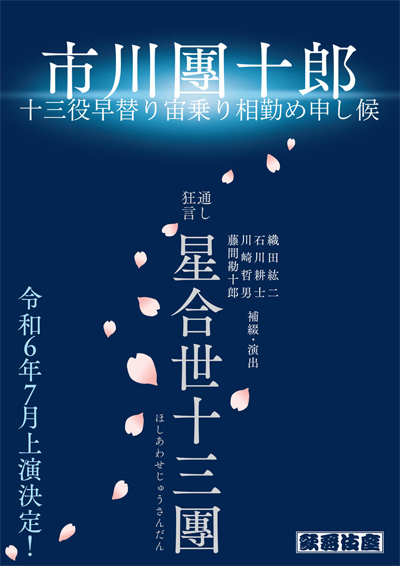 |
 |
 |
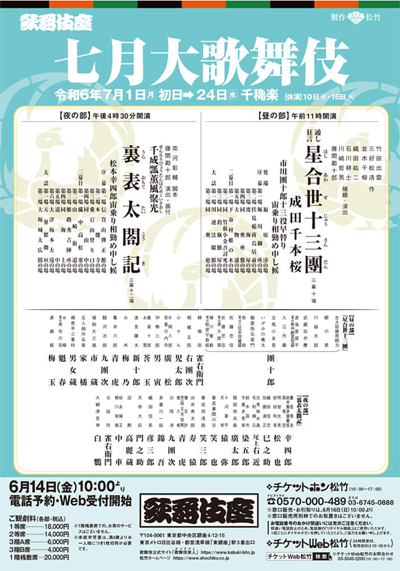 |
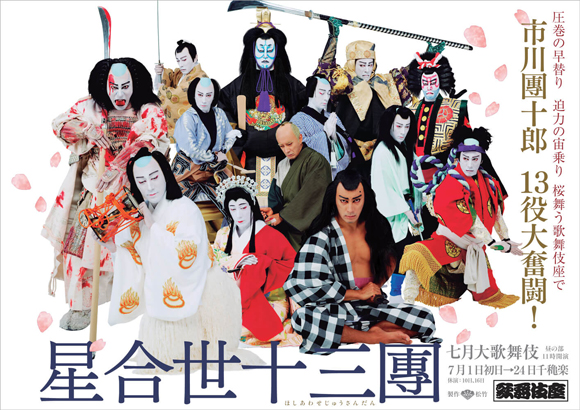 |
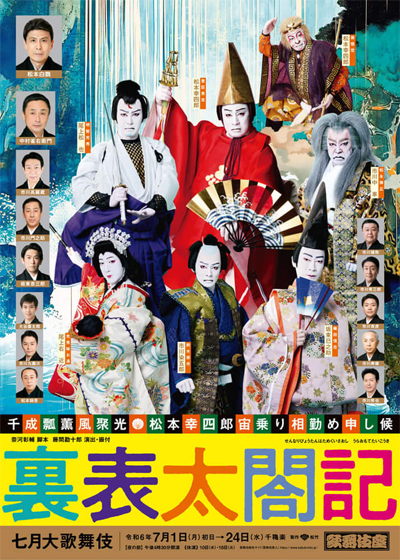 |
| Dates | 25 July 2024 Band˘ Tamasabur˘ x Shunpűtei Koasa Kabukiza Tokubetsu K˘en Band˘ Tamasabur˘ x Shunpűtei Koasa Kabukiza Special Performance |
| Program |
Koshiji Fubuki Monogatari |
| Casting |
Living National Treasure Band˘ Tamasabur˘, Shunpűtei Koasa |
| Comments |
A special program at the Kabukiza starring Living National Treasure onnagata Band˘ Tamasabur˘ with the rakugo storyteller Shunpűtei Koasa. |
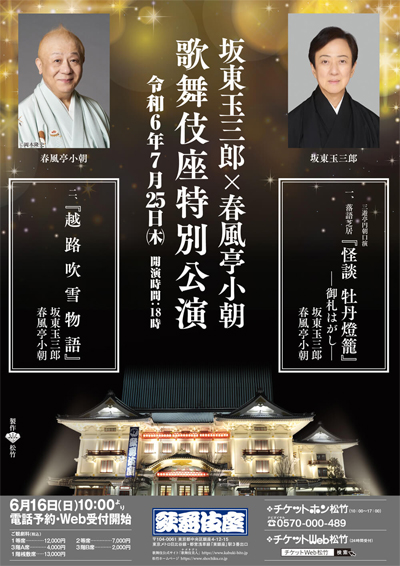 |
| Tiara K˘t˘ (T˘ky˘) |  |
| Dates | 5 ~ 12 July 2024 Shichigatsu Kabuki Kansh˘ Ky˘shitsu July Kabuki Appreciation Class |
| Program |
Kabuki no Mikata |
| Casting |
Nakamura Shikan, Nakamura Matsue, Band˘ Shingo, Nakamura Hashinosuke, Nakamura Fukunosuke, Nakamura Utanosuke, Nakamura Kamenoj˘, Nakamura Tamatar˘ |
| Comments |
Educational program at the Tiara K˘t˘ in T˘ky˘ called Kabuki Kansh˘ Ky˘shitu ("Kabuki Appreciation Class"). This is a very interesting formula for the beginners because there is lively presentation on stage (Kabuki no Mikata) of Kabuki or some aspects of the art like music, stage tricks or fighting scenes. It is followed by "Kawatsura H˘gen Yakata".
|
| Ch˘fu City Green Hall (Ch˘fu) |
| Dates | 18 ~ 27 July 2024 Shichigatsu Kabuki Kansh˘ Ky˘shitsu July Kabuki Appreciation Class |
| Program |
Kabuki no Mikata |
| Casting |
Nakamura Shikan, Nakamura Matsue, Band˘ Shingo, Nakamura Hashinosuke, Nakamura Fukunosuke, Nakamura Utanosuke, Nakamura Kamenoj˘, Nakamura Tamatar˘ |
| Comments |
Educational program at the Ch˘fu City Green Hall in Ch˘fu called Kabuki Kansh˘ Ky˘shitu ("Kabuki Appreciation Class"). This is a very interesting formula for the beginners because there is lively presentation on stage (Kabuki no Mikata) of Kabuki or some aspects of the art like music, stage tricks or fighting scenes. It is followed by "Kawatsura H˘gen Yakata". |
| Sh˘chiku Special Kabuki Tour | |
| Dates | 30 June ~ 31 July 2024 Sh˘chiku Tokubetsu Kabuki Sh˘chiku Special Kabuki |
| Program |
Nakamura Shid˘ no HOW TO Kabuki |
| Casting |
Nakamura Shid˘, Nakamura Tanenosuke, Sawamura Kuniya, Nakamura Ch˘ichi, Nakamura Ch˘shi, Nakamura Haruki |
| Comments |
A Sh˘chiku Special Kabuki Summer Tour led by Nakamura Shid˘.
|
 |
|
|||
| Dates | 12 ~ 15 July 2024 (Shinshű Matsumoto ďkabuki) Shinshű Matsumoto Grand Kabuki [official website] |
||
| Program |
Fuku Kanau Kami no Koibana |
||
| Casting |
Nakamura Kankur˘, Nakamura Shichinosuke, Nakamura Toranosuke, Nakamura Tsurumatsu, Nakamura Kantar˘, Nakamura Ch˘zabur˘ |
||
| Comments |
8th edition in the city of Matsumoto (first time in July 2008; second time in July 2010; third time in July 2012; fourth time in July 2014); fifth time in July 2016; sixth time in June 2018; seventh time in June 2021) of a Kabuki program, which is called Shinshű Matsumoto ďkabuki (Shinshű is an old name for the province of Nagano, whose main city is Matsumoto). Same program as the 1st edition of the Kabukich˘ Grand Kabuki right in T˘ky˘ in May 2024:
|
||
 |
|
|
| Contact | Main | Top | Updates | Actors | Plays | Playwrights | Programs | Links | FAQ | Glossary | Chronology | Illustrations | Prints | Characters | Derivatives | Theaters | Coming soon | News |
